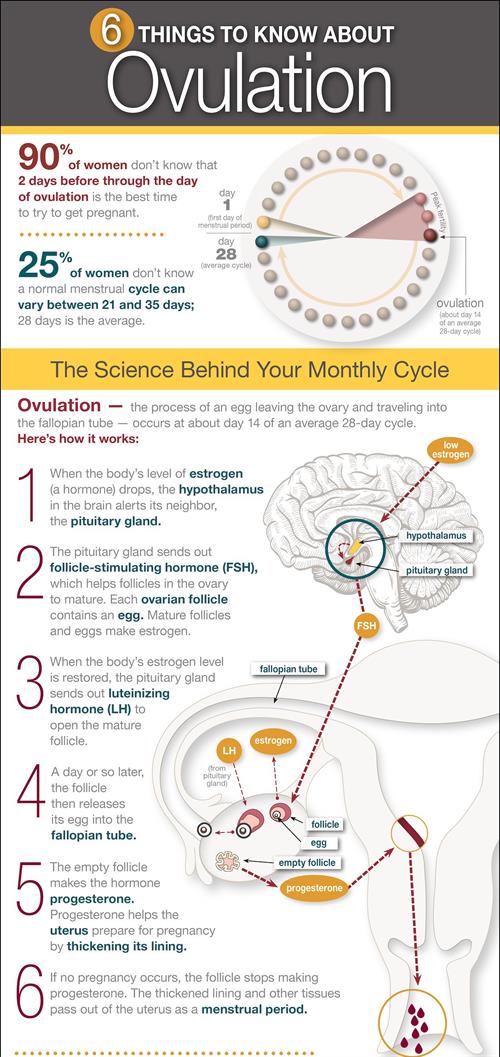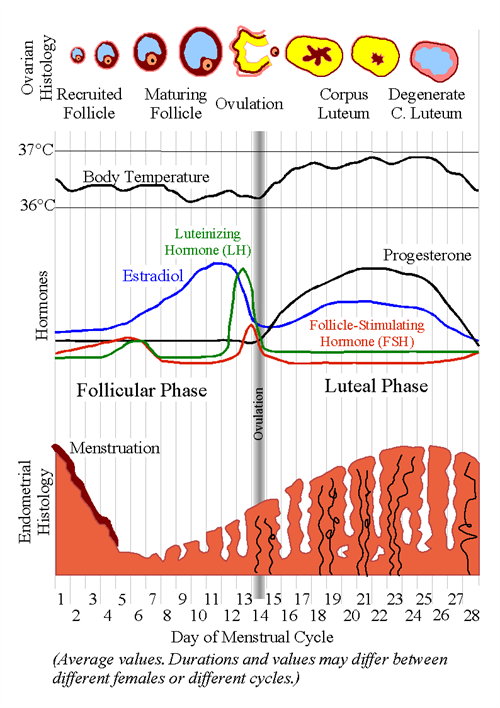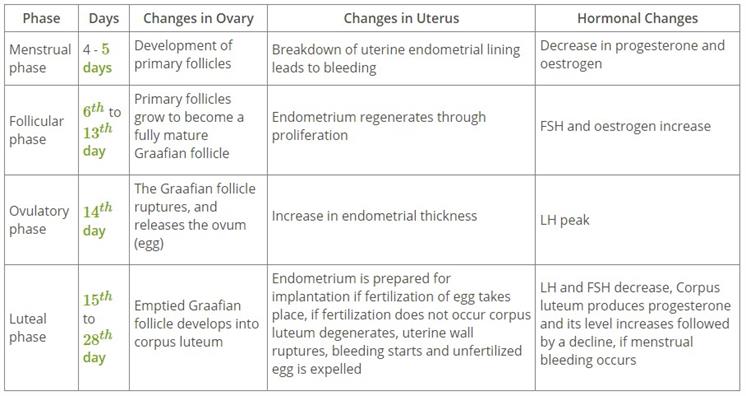PDF chapter test TRY NOW
Let us now look in detail at what happens in each of the phases of the menstrual cycle. 


Menstrual Phase:
In a \(28\) day menstrual cycle, the menstrual phase takes place for the first \(4\) - \(5\) days. The production of \(LH\) from the anterior pituitary is reduced. The decrease in the \(LH\) causes degeneration of the corpus luteum and reduces the production of progesterone. The production of oestrogen is also reduced.

Regulation of menstrual cycle
The changes that occur in the ovary include:
- Degeneration of unfertilised ovum.
- Degeneration of corpus luteum.
- Maturation or development of the primary follicles.
The changes that occur in the uterus include:
- The endometrium lining of the uterus gets thickened for the implantation of the zygote before the menstrual phase.
- The endometrium lining, blood vessels, and degenerated ovum sheds off and get discharged through the vagina. This is called menstrual bleeding.
Follicular phase or Proliferative phase:
The follicular phase takes place from the \(6^{th}\) to the \(13^{th}\) day in a \(28\)-day cycle. The anterior pituitary secretes the follicle-stimulating hormone (FSH). FSH, in turn, stimulates the ovarian follicle to secrete oestrogen.
Oestrogen secreted by the follicles stimulates the proliferation of the endometrium of the uterus walls.
The changes that occur in the ovary include:
- The development of primary follicles occur. Primary follicles grow to become a mature Graafian follicle.
- The matured ovum is formed in the Graafian follicles.
- During the maturation of the ovum, the Graafian follicle secrets the oestrogen hormone.
The changes that occur in the uterus include:
- The secretion of oestrogen stimulates the uterus for endometrial thickening.
- Endometrium regenerates through proliferation.
Ovulatory phase:
Both the hormones \(LH\) and \(FSH\) attain a peak level in the middle of the cycle. The ovulatory phase takes place on about the \(14^{th}\) day of the cycle. The secretion of the \(LH\) causes the rupture of the Graafian follicle that releases the ovum. This process is termed as ovulation.
Ovulation is the rupture of the follicle releasing the egg or ovum.
The changes that occur in the ovary include:
- The rupture of the Graafian follicle takes place.
- The matured ovum is released from the ovary and enters the fallopian tube.
- Ovulation takes place, and the ovum remains in the fallopian tube for \(24\) hours.
Secretory phase:
This phase takes place from the \(15^{th}\) to the \(28^{th}\) day in a \(28\)-day cycle. LH is secreted by the anterior pituitary that causes ovulation. \(LH\) stimulates the remaining cells of ovarian follicles to develop the corpus luteum. The corpus luteum releases progesterone.
Progesterone is required for the maintenance of the endothelium if implantation of the fertilised egg occurs. In the absence of fertilisation, the corpus luteum degenerates. There is the disintegration of endothelium that leads to menstruation that marks the new menstrual cycle.
The changes that occur in the ovary include:
- The Graafian follicle is converted to corpus luteum.
- The Corpus luteum releases progesterone.
The changes that occur in the uterus include:
- Progesterone helps in the further thickening of the uterus.
- Uterus provides a suitable environment for the development of the embryo.
- If the ovum is fertilised, it gets implanted in the uterus. Under these circumstances, the menstrual cycle ceases until the delivery of the newborn.
- If the ovum is unfertilised, degeneration of the ovum occurs, which results in menstrual bleeding.
Important!
Menstruation is a periodical phenomenon that starts from puberty and continues till menopause. Menstruation occurs if the released ovum is not fertilised by the sperm. Lack of menstruation generally indicates pregnancy.

Menstrual cycle
The events that occur in the menstrual cycle and the role of hormones in the cycle is summarised below:

The following video displays the various phases of the menstrual cycle:
Reference:
https://www.youtube.com/watch?v=ZNM8KsSQerk
https://upload.wikimedia.org/wikipedia/commons/c/cd/MenstrualCycle2.png
https://www.flickr.com/photos/nihgov/23179830410/in/photostream/
